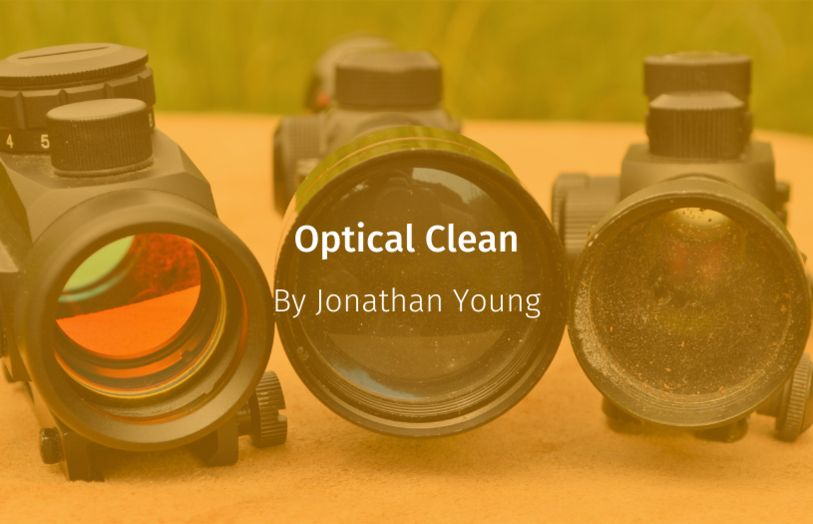
AirMaks Arms at The British Shooting Show
News Events
Create a FREE business profile and join our directory to showcase your services to thousands.
Create my profile now!
What is the best way to look after your scope and other shooting optics? Jonathan Young peers through the lens on the subject of cleaning.
Optics of any description are a dirt magnet and mucky fingerprints don't even come close to being the worst of the crud that ends up sitting on your scope's lenses. Taking a walk or going shooting near the coast on a breezy day and your sunglasses, eyeglasses and scope may show a misty clouding of salt spray drifting inland on the wind. Shooting anywhere dusty such as in farmyard barns at harvest time when clearing rats could likewise attract a similar light film of hazy dirt. Don't forget summer out in the fields, which could mean a haze of sticky pollen over optics. These situations in themselves are a nuisance but worse the lens can now attract even more dirt. Dirt likes to stick to dirt. Scope lenses may need some form of cleaning at some stage in their use.
Fitting flip-up lens caps is a very good idea to prevent problems. See-through scope caps can be useful although personally any used here have been made from poorer plastics that don’t match the quality of the scope they are fitted to. When things eventually need a clean, some people will use the edge of a woolly sweater or drag an old hanky out of a dirty trouser pocket and no prizes for guessing what happens. Glass and optical quality plastics used in lens manufacturing are resilient - to a point. Many can be quite 'soft'. These are now usually always coated. These coatings reduce glare and improve clarity just as with eyeglasses lenses but they’re only microns thick. Cleaning any such coated surface increases the risk of scratches, if not to the lens at least to any such coatings.
Brush out and allow to fall away, a blower brush can help lift loose dirt
When to clean and how often is a personal choice. Cleaning will by default involve some abrasion and cleaning any dirty optical surface will eventually cause some deterioration. Harsh but true. Personally, I avoid spending out huge sums on fancy scopes as I still enjoy using open sights and the few scopes I do have can all be replaced cheaply if they become too scratched. However, I would still want to keep a favourite go-to scope in clean tip-top condition irrespective of how little it cost.
Using a proper glass cleaning cloth as sold by opticians won’t avoid damage if some attempt isn’t made first to remove any dirt particles. A brush with long soft bristles has been found useful by many to remove debris, one with a plastic ferrule rather than metal as if used carelessly this can drag and obviously cause worse damage than just dirt. A camera lens brush with a plastic casing and a photographic blower brush have been found to be very useful for this pre-cleaning stage. Some make-up cosmetics brushes have also been found to be useful for this job. Brushing gently and blowing to dislodge any debris, the dirt can be encouraged to fall away through gravity alone by pointing the scope downwards. Debris also gets into the lens retaining ring threads if present so again a brush can run around any metal rims, overhangs or crevices to dislodge dirt out. Care in brushing should avoid particles getting dragged back and forth over the optic's surface.
Lens cleaning fluids or wipes. Read instructions to check for compatibility.
It’s a good idea to never allow the scope to get dirty enough to need further stages of cleaning, all of which can invite further wear and scratching no matter how delicately they’re performed. If the glass is clean enough at this stage some owners believe it’s prudent to call time. Less is more and there may be no point in cleaning further if it’s not necessary. If further cleaning is called for some owners swear by lens cleaning fluid. Squirting this directly over the glass the liquid can get easily drawn into the lens body which isn’t good on any scope. On older vintage scopes the lenses may be two lenses cemented together into a group. What’s referred to as balsam separation can occur all too easily with age. Allowing such cleaning fluids to filter through to get between cemented lenses cannot be a good idea.
Many will run some fluid onto a lens cleaning cloth first then gently apply this to the glass. Disposable optical wipes in silver foil packets that are soaked in fluid are also available. Bottles of chemical cleaning agents can also be found. In both the above cases it’s best to check compatibility as some fluids may not be suitable on some coatings or lenses.
A two-element front lens group, glued together so never a good idea to allow cleaning fluids to seep between these
Very light strokes should be all that's needed to remove any smudge marks and fingerprints. This may conclude the cleaning, but as some liquid agents can dry blotchy most people will naturally want to wipe residue marks away with a separate cloth later. Opticians and camera suppliers sell especially soft cloths for cleaning optics. It’s however still very important not to overdo this. In effect, using any cloth to wipe a surface can result in abrasion cleaning. One small speck of debris lurking in a recess may now get scoured over the surface. Terms like 'polishing glass' will invite trouble too. In the truest sense of the word the polishing of any optical surface, if really needed, should be done by a trained optical technician.


